University Name: Organizational Commitment Strategies Report
VerifiedAdded on 2023/01/18
|6
|1099
|47
Report
AI Summary
This report examines strategies for building organizational commitment within a business context. It begins by defining organizational commitment as the psychological attachment of employees to their organization, emphasizing its impact on employee retention and performance. The report then explores several key strategies, including fostering a strong teamwork culture, ensuring clear communication of objectives, promoting transparency, cultivating a positive work environment, building trust, supporting employee development and career advancement, ensuring justice and support, and establishing shared values. Each strategy is discussed in detail, highlighting its significance and practical implications. The report concludes by summarizing the importance of employee satisfaction and engagement in driving business success, emphasizing the role of these strategies in creating a more committed and productive workforce. The report references several academic sources to support its claims. The assignment is a persuasive argument short report and follows the format outlined in the brief, addressing key elements such as introduction, body paragraphs, and conclusion.
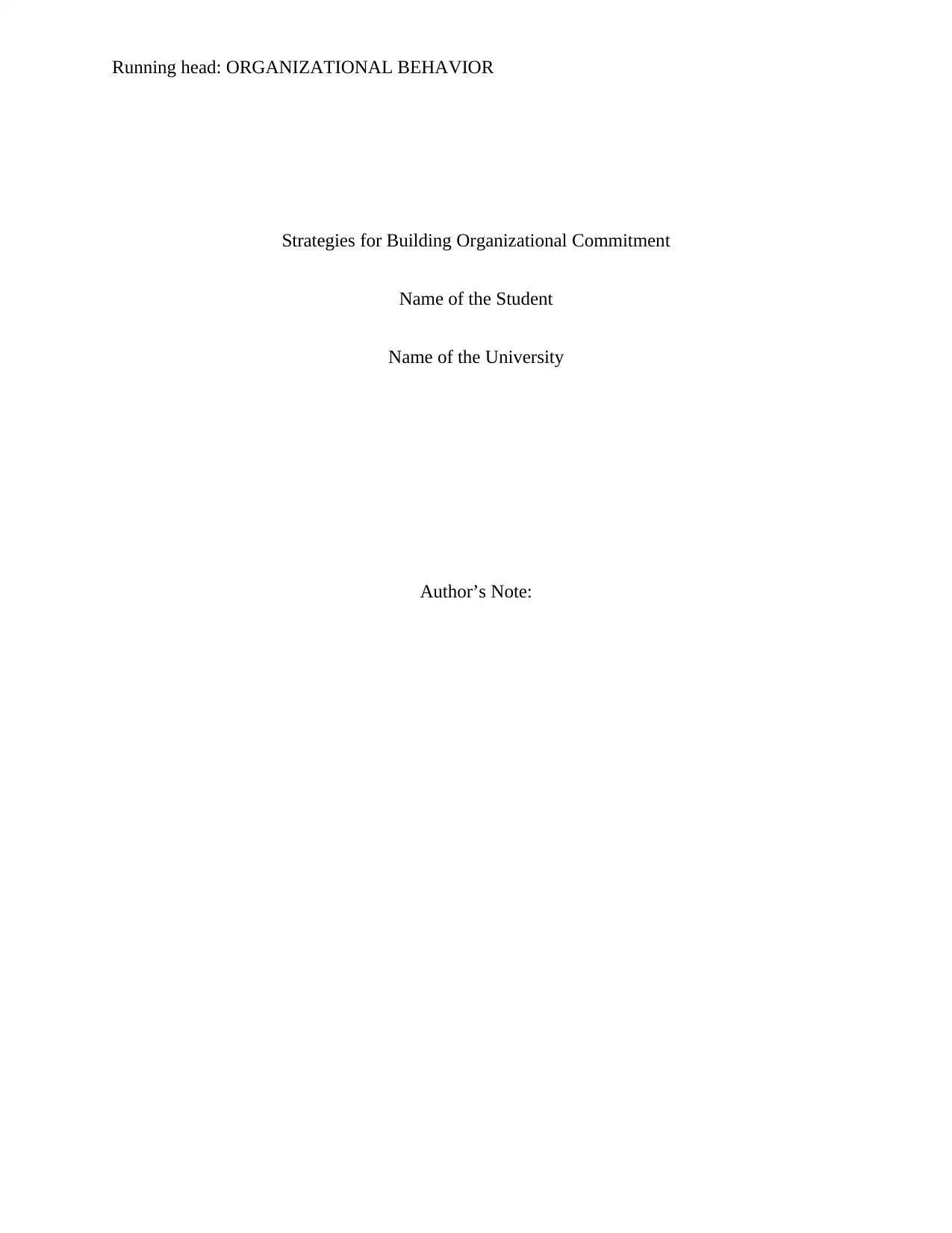
Running head: ORGANIZATIONAL BEHAVIOR
Strategies for Building Organizational Commitment
Name of the Student
Name of the University
Author’s Note:
Strategies for Building Organizational Commitment
Name of the Student
Name of the University
Author’s Note:
Paraphrase This Document
Need a fresh take? Get an instant paraphrase of this document with our AI Paraphraser
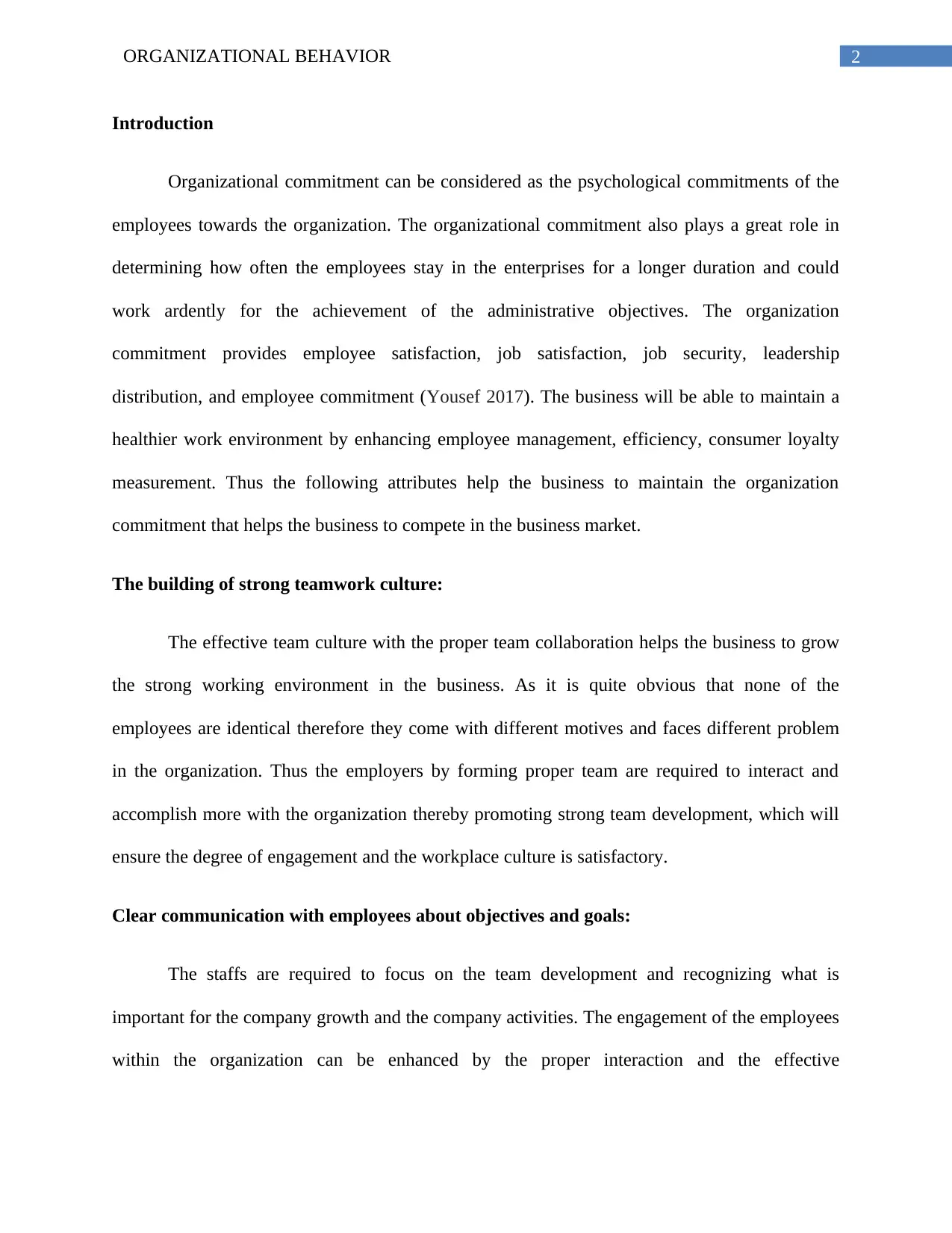
2ORGANIZATIONAL BEHAVIOR
Introduction
Organizational commitment can be considered as the psychological commitments of the
employees towards the organization. The organizational commitment also plays a great role in
determining how often the employees stay in the enterprises for a longer duration and could
work ardently for the achievement of the administrative objectives. The organization
commitment provides employee satisfaction, job satisfaction, job security, leadership
distribution, and employee commitment (Yousef 2017). The business will be able to maintain a
healthier work environment by enhancing employee management, efficiency, consumer loyalty
measurement. Thus the following attributes help the business to maintain the organization
commitment that helps the business to compete in the business market.
The building of strong teamwork culture:
The effective team culture with the proper team collaboration helps the business to grow
the strong working environment in the business. As it is quite obvious that none of the
employees are identical therefore they come with different motives and faces different problem
in the organization. Thus the employers by forming proper team are required to interact and
accomplish more with the organization thereby promoting strong team development, which will
ensure the degree of engagement and the workplace culture is satisfactory.
Clear communication with employees about objectives and goals:
The staffs are required to focus on the team development and recognizing what is
important for the company growth and the company activities. The engagement of the employees
within the organization can be enhanced by the proper interaction and the effective
Introduction
Organizational commitment can be considered as the psychological commitments of the
employees towards the organization. The organizational commitment also plays a great role in
determining how often the employees stay in the enterprises for a longer duration and could
work ardently for the achievement of the administrative objectives. The organization
commitment provides employee satisfaction, job satisfaction, job security, leadership
distribution, and employee commitment (Yousef 2017). The business will be able to maintain a
healthier work environment by enhancing employee management, efficiency, consumer loyalty
measurement. Thus the following attributes help the business to maintain the organization
commitment that helps the business to compete in the business market.
The building of strong teamwork culture:
The effective team culture with the proper team collaboration helps the business to grow
the strong working environment in the business. As it is quite obvious that none of the
employees are identical therefore they come with different motives and faces different problem
in the organization. Thus the employers by forming proper team are required to interact and
accomplish more with the organization thereby promoting strong team development, which will
ensure the degree of engagement and the workplace culture is satisfactory.
Clear communication with employees about objectives and goals:
The staffs are required to focus on the team development and recognizing what is
important for the company growth and the company activities. The engagement of the employees
within the organization can be enhanced by the proper interaction and the effective
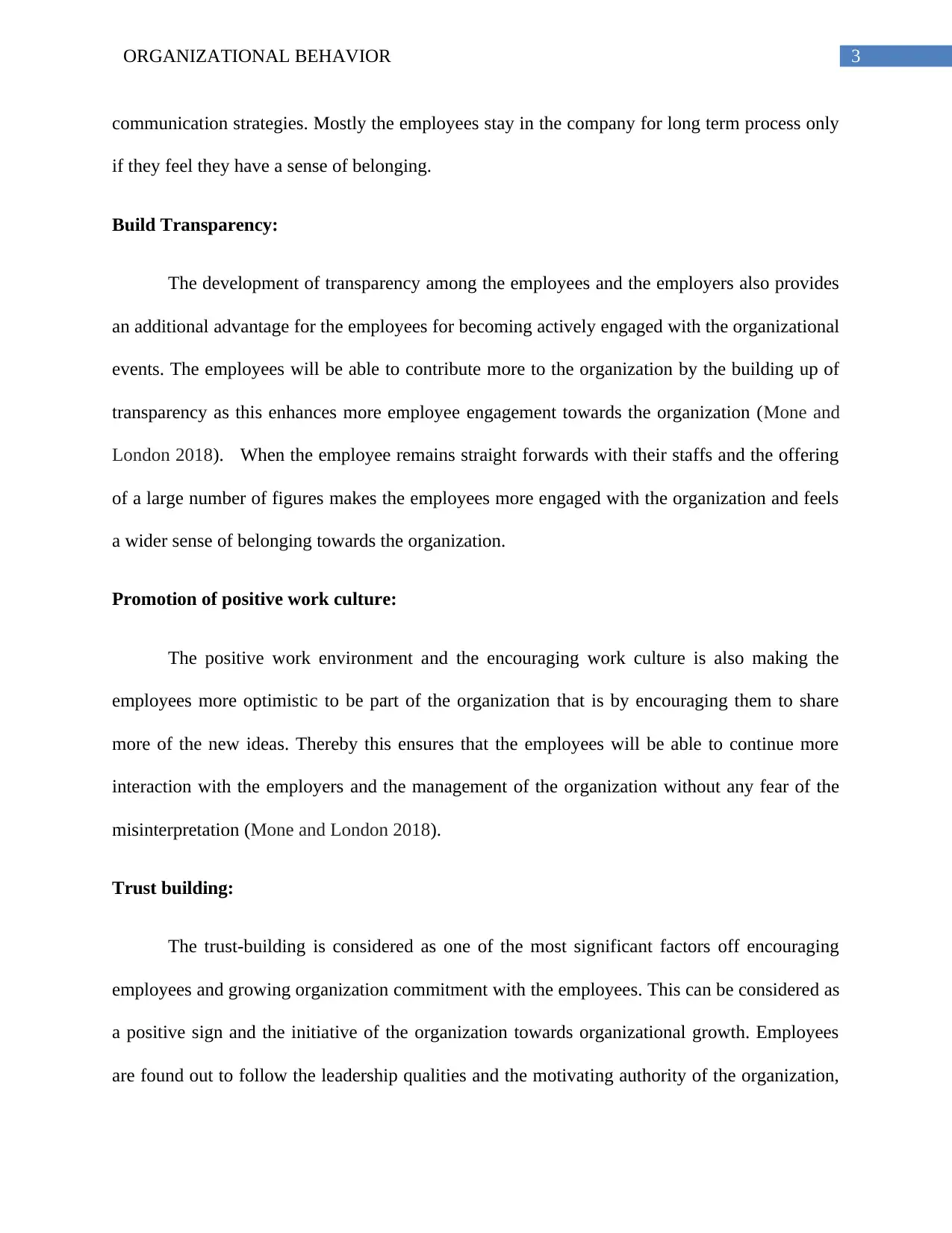
3ORGANIZATIONAL BEHAVIOR
communication strategies. Mostly the employees stay in the company for long term process only
if they feel they have a sense of belonging.
Build Transparency:
The development of transparency among the employees and the employers also provides
an additional advantage for the employees for becoming actively engaged with the organizational
events. The employees will be able to contribute more to the organization by the building up of
transparency as this enhances more employee engagement towards the organization (Mone and
London 2018). When the employee remains straight forwards with their staffs and the offering
of a large number of figures makes the employees more engaged with the organization and feels
a wider sense of belonging towards the organization.
Promotion of positive work culture:
The positive work environment and the encouraging work culture is also making the
employees more optimistic to be part of the organization that is by encouraging them to share
more of the new ideas. Thereby this ensures that the employees will be able to continue more
interaction with the employers and the management of the organization without any fear of the
misinterpretation (Mone and London 2018).
Trust building:
The trust-building is considered as one of the most significant factors off encouraging
employees and growing organization commitment with the employees. This can be considered as
a positive sign and the initiative of the organization towards organizational growth. Employees
are found out to follow the leadership qualities and the motivating authority of the organization,
communication strategies. Mostly the employees stay in the company for long term process only
if they feel they have a sense of belonging.
Build Transparency:
The development of transparency among the employees and the employers also provides
an additional advantage for the employees for becoming actively engaged with the organizational
events. The employees will be able to contribute more to the organization by the building up of
transparency as this enhances more employee engagement towards the organization (Mone and
London 2018). When the employee remains straight forwards with their staffs and the offering
of a large number of figures makes the employees more engaged with the organization and feels
a wider sense of belonging towards the organization.
Promotion of positive work culture:
The positive work environment and the encouraging work culture is also making the
employees more optimistic to be part of the organization that is by encouraging them to share
more of the new ideas. Thereby this ensures that the employees will be able to continue more
interaction with the employers and the management of the organization without any fear of the
misinterpretation (Mone and London 2018).
Trust building:
The trust-building is considered as one of the most significant factors off encouraging
employees and growing organization commitment with the employees. This can be considered as
a positive sign and the initiative of the organization towards organizational growth. Employees
are found out to follow the leadership qualities and the motivating authority of the organization,
⊘ This is a preview!⊘
Do you want full access?
Subscribe today to unlock all pages.

Trusted by 1+ million students worldwide

4ORGANIZATIONAL BEHAVIOR
this helps to bring basic changes in the organization and the manager’s attitude also reflects on
the employee’s behavior. Like the engagement of the employees in the decision-making process
helps the employees to feel more responsible for the business and enhances the employment
relationship (Mone and London 2018).
Improve development:
The career advancement and the growth of job careers make the employees more
motivated towards the organization. This prevents the individuals from demoralizing themselves
rater they feel better by inspiring themselves which leads to the development of intelligent
thoughts (Bailey et al. 2017). The company is required to delegate the tasks as per the
employee’s specialization field thereby bring improvement in the organizational operation
process.
Justice and Support:
The employee’s loyalty in the organization fulfills the obligation of the employees like
the justice, forgiveness approach, moral integrity, and human values. The manager of the
organization is required to ensure the impartiality of decision like the allocation of the incentives
and resources (Cohen 2017). Therefore this is found out that the employee’s loyalty is directly
linked to the justice where the staff can get from the company.
Shared Values:
The corporate engagement is considered as the identification of the individual with the
organization becomes higher when the employee’s beliefs and the employee’s ideas confirm that
this helps to bring basic changes in the organization and the manager’s attitude also reflects on
the employee’s behavior. Like the engagement of the employees in the decision-making process
helps the employees to feel more responsible for the business and enhances the employment
relationship (Mone and London 2018).
Improve development:
The career advancement and the growth of job careers make the employees more
motivated towards the organization. This prevents the individuals from demoralizing themselves
rater they feel better by inspiring themselves which leads to the development of intelligent
thoughts (Bailey et al. 2017). The company is required to delegate the tasks as per the
employee’s specialization field thereby bring improvement in the organizational operation
process.
Justice and Support:
The employee’s loyalty in the organization fulfills the obligation of the employees like
the justice, forgiveness approach, moral integrity, and human values. The manager of the
organization is required to ensure the impartiality of decision like the allocation of the incentives
and resources (Cohen 2017). Therefore this is found out that the employee’s loyalty is directly
linked to the justice where the staff can get from the company.
Shared Values:
The corporate engagement is considered as the identification of the individual with the
organization becomes higher when the employee’s beliefs and the employee’s ideas confirm that
Paraphrase This Document
Need a fresh take? Get an instant paraphrase of this document with our AI Paraphraser
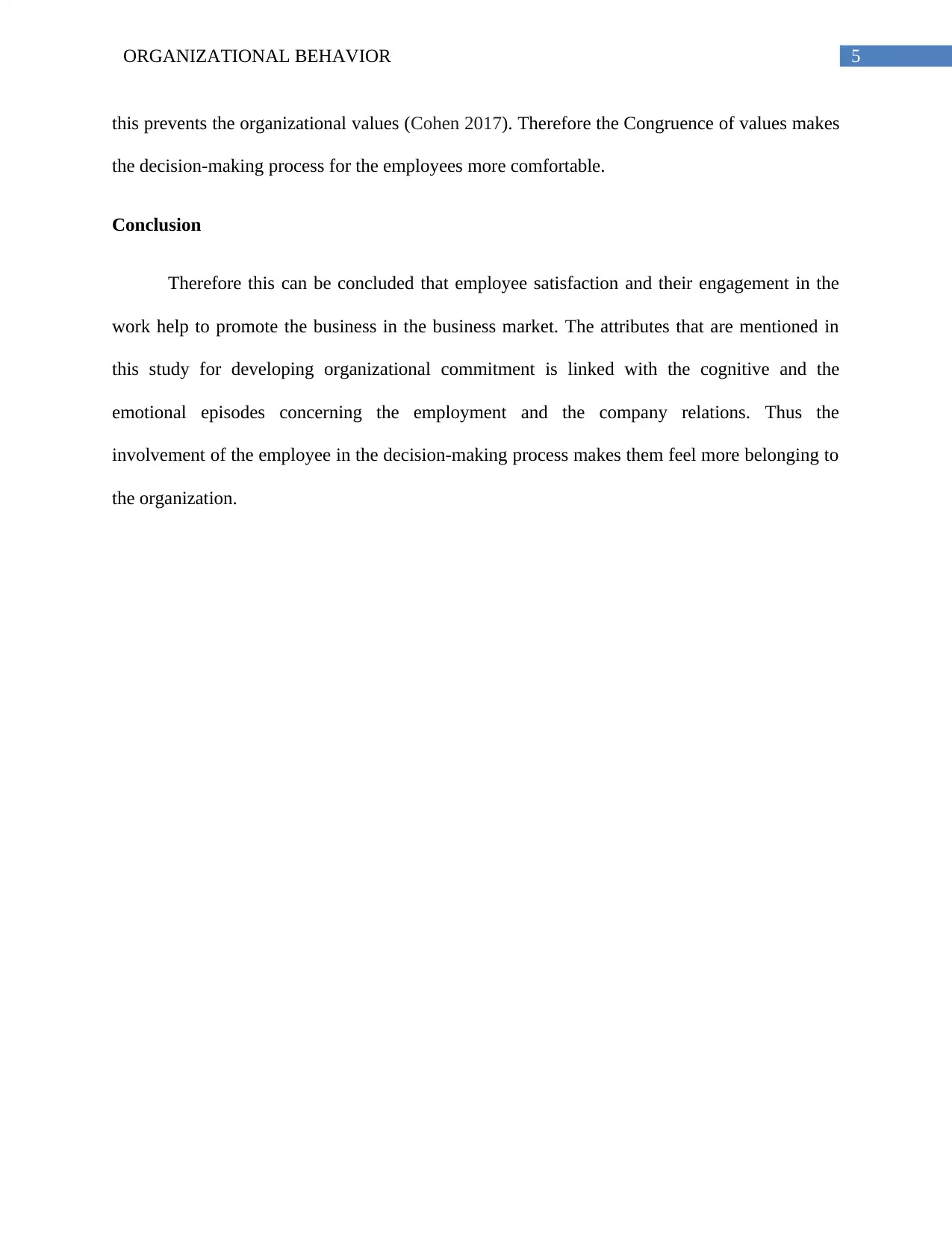
5ORGANIZATIONAL BEHAVIOR
this prevents the organizational values (Cohen 2017). Therefore the Congruence of values makes
the decision-making process for the employees more comfortable.
Conclusion
Therefore this can be concluded that employee satisfaction and their engagement in the
work help to promote the business in the business market. The attributes that are mentioned in
this study for developing organizational commitment is linked with the cognitive and the
emotional episodes concerning the employment and the company relations. Thus the
involvement of the employee in the decision-making process makes them feel more belonging to
the organization.
this prevents the organizational values (Cohen 2017). Therefore the Congruence of values makes
the decision-making process for the employees more comfortable.
Conclusion
Therefore this can be concluded that employee satisfaction and their engagement in the
work help to promote the business in the business market. The attributes that are mentioned in
this study for developing organizational commitment is linked with the cognitive and the
emotional episodes concerning the employment and the company relations. Thus the
involvement of the employee in the decision-making process makes them feel more belonging to
the organization.
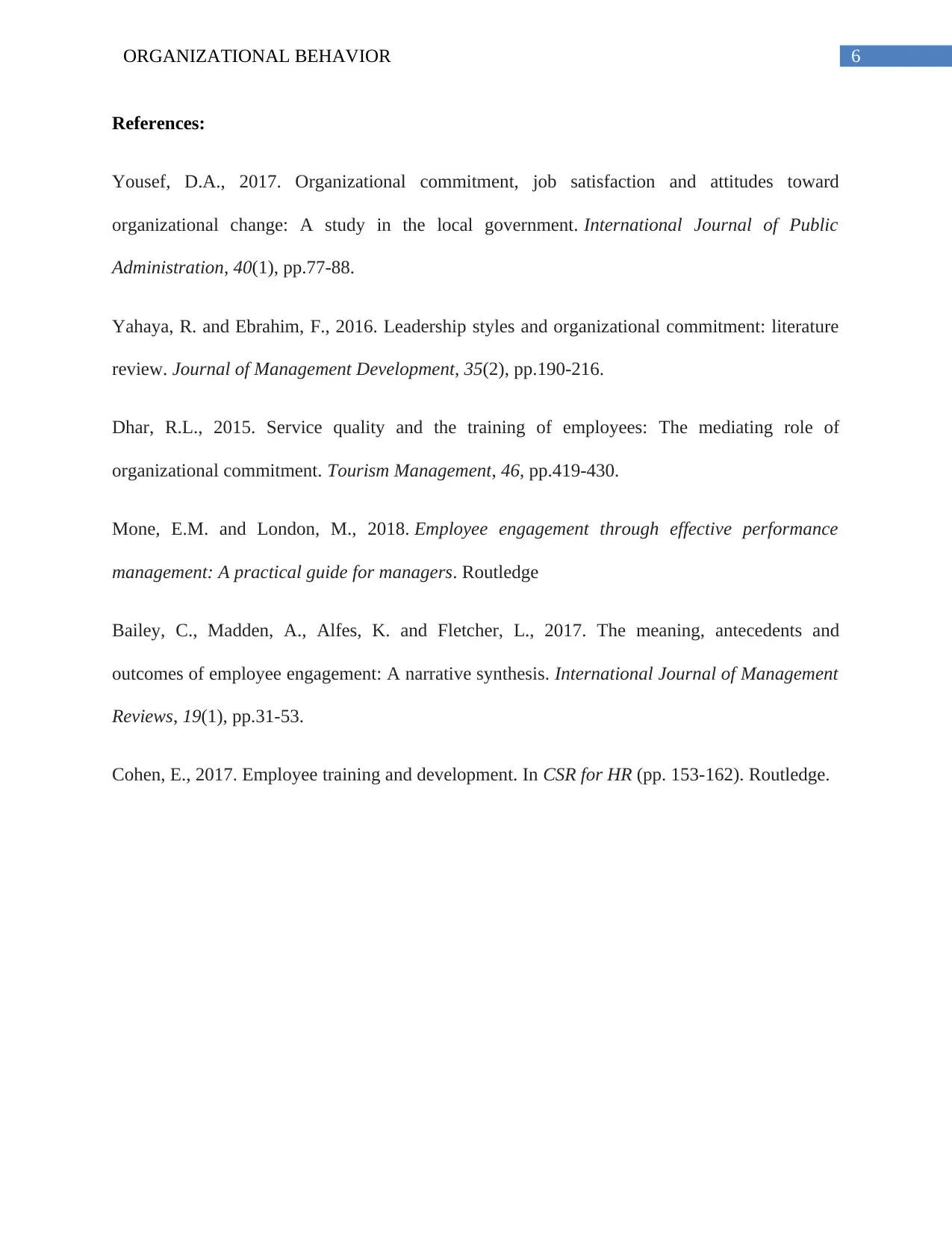
6ORGANIZATIONAL BEHAVIOR
References:
Yousef, D.A., 2017. Organizational commitment, job satisfaction and attitudes toward
organizational change: A study in the local government. International Journal of Public
Administration, 40(1), pp.77-88.
Yahaya, R. and Ebrahim, F., 2016. Leadership styles and organizational commitment: literature
review. Journal of Management Development, 35(2), pp.190-216.
Dhar, R.L., 2015. Service quality and the training of employees: The mediating role of
organizational commitment. Tourism Management, 46, pp.419-430.
Mone, E.M. and London, M., 2018. Employee engagement through effective performance
management: A practical guide for managers. Routledge
Bailey, C., Madden, A., Alfes, K. and Fletcher, L., 2017. The meaning, antecedents and
outcomes of employee engagement: A narrative synthesis. International Journal of Management
Reviews, 19(1), pp.31-53.
Cohen, E., 2017. Employee training and development. In CSR for HR (pp. 153-162). Routledge.
References:
Yousef, D.A., 2017. Organizational commitment, job satisfaction and attitudes toward
organizational change: A study in the local government. International Journal of Public
Administration, 40(1), pp.77-88.
Yahaya, R. and Ebrahim, F., 2016. Leadership styles and organizational commitment: literature
review. Journal of Management Development, 35(2), pp.190-216.
Dhar, R.L., 2015. Service quality and the training of employees: The mediating role of
organizational commitment. Tourism Management, 46, pp.419-430.
Mone, E.M. and London, M., 2018. Employee engagement through effective performance
management: A practical guide for managers. Routledge
Bailey, C., Madden, A., Alfes, K. and Fletcher, L., 2017. The meaning, antecedents and
outcomes of employee engagement: A narrative synthesis. International Journal of Management
Reviews, 19(1), pp.31-53.
Cohen, E., 2017. Employee training and development. In CSR for HR (pp. 153-162). Routledge.
⊘ This is a preview!⊘
Do you want full access?
Subscribe today to unlock all pages.

Trusted by 1+ million students worldwide
1 out of 6
Related Documents
Your All-in-One AI-Powered Toolkit for Academic Success.
+13062052269
info@desklib.com
Available 24*7 on WhatsApp / Email
![[object Object]](/_next/static/media/star-bottom.7253800d.svg)
Unlock your academic potential
Copyright © 2020–2025 A2Z Services. All Rights Reserved. Developed and managed by ZUCOL.




